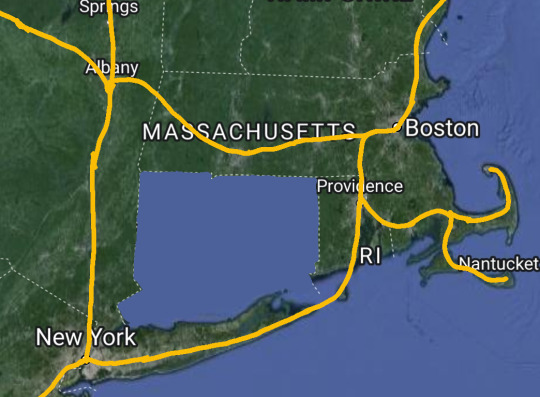#high speed rail network
Photo

China’s High Speed Railway network overlaid on the United States
2K notes
·
View notes
Text
vimeo
High-Speed Rail In India - A Game-Changer For Transportation
With the advent of High-Speed Rail, the Indian railway system, rated as the world's fourth-largest railway network, is experiencing a massive overhaul. This change is expected to result in quicker travel, environmental advantages, economic growth, and increased connectivity. The ambitious Mumbai-Ahmedabad High-Speed Rail Corridor and subsequent expansions are intended to transform Indian railways. While there will be obstacles ahead, smart planning and public awareness can ensure that High-Speed Rail in India becomes a driving force in changing railways.
#railways#indian railways#railway in India#Indian railway system#largestrailwaynetwork#high speed rail#world largest railway network#railwaynetwork#railways of India#Vimeo
0 notes
Text
CPK to Design First High-Speed Railway Line in Poland
CPK to Design First High-Speed Railway Line in Poland
Centralny Port Komunikacyjny (CPK) has selected several consortiums to design Poland’s first high-speed railway line.
The 140-kilometre railway line will be designed in three phases. The first phase concerns the section from Warsaw to the CPK Airport transport hub, while the second will extend the line up to the city of Łódź. The third phase will then develop GSM-R radio communication along the…

View On WordPress
#AC#ATO#bi#CER#Construction#contracts#design#EC#Egis#era#EU#gr#GSM-R#High-Speed#high-speed rail#ICE#Infrastructure#investment#IT#network#News#NS#Poland#Proje#RAI#Rail Infrastructure#Sel#Ski#Spor#US
0 notes
Text
Musk never had any intention of building the Hyperloop. He only needed it to help kill or substantially delay the high-speed rail project and the alternate vision of sustainable collective transportation it offered. It threatened his interests as an automaker and his elite vision of “individualized” mobility that simply worked better for him.
[...]
In the time since California started talking about high-speed rail and Elon Musk interjected with his fantasy to help sidetrack it, China moved ahead and built a network consisting of 42,000 kilometres (26,000 miles) of track. Europe is continuing to expand its own network, and Japan is building a maglev line that will run at speeds of over 500 km/h (310 mph). The first segment from Tokyo to Nagoya could open by 2027. Not to be outdone, China is working on a maglev of its own to beat its Japanese rivals.
While the Hyperloop deception spread far and wide, nowhere was it stronger than in the United States. As countries around the world moved forward with real transport improvements, North Americans were distracted by the fantasies of clueless, but self-confident tech moguls. They left people trapped in their cars and denied better options to get around that people in many other parts of the world — even those that are quite a bit poorer — take for granted. Now all they can do is shovel money at automakers to try to power cars with batteries instead of internal combustion engines. They have no vision for a better, less car dependent alternative.
1K notes
·
View notes
Text
youtube
#high speed train#powerful#indian railways#indianrail#indian rail network#phulwari sharif#patna#dangerous#Youtube
1 note
·
View note
Text
Vietnam aims to start building two high-speed railway lines linking its capital Hanoi with China before 2030, the Ministry of Planning and Investment said, another sign of a recent warming of ties between the two communist-ruled neighbours.
China is Vietnam’s largest trading partner and a vital source of imports for its manufacturing sector. The two countries are already connected via a system of highways and two railway lines that are old and need upgrading on the Vietnam side.
One of the planned high-speed lines would run from Vietnam’s port cities of Haiphong and Quang Ninh through Hanoi to Lao Cai province, which borders China’s Yunnan province, the ministry said in a statement released late on Tuesday.
The other would run from Hanoi to Lang Son province, which borders China’s Guangxi region, passing through an area densely populated with global manufacturing facilities, including some owned by Chinese investors.[...]
Earlier this month, Vietnam said it was seeking to learn from China to develop its first high-speed railway network and had sent its officials to work with Chinese railway companies.
A massive high-speed railway line linking capital Hanoi with business hub Ho Chi Minh City is also being planned in the country.

10 Apr 24
214 notes
·
View notes
Text
Imagine: one day we are finally retiring the cross-country high-speed rail networks, but it's not a time for sadness, but joy: we've got something better.
Every city has a portal hub. Big cities have dozens. You can get to any inhabited place on the planet in under a half hour. Take a tram to the hub, hop through a portal, and you can go see all your internet friends in their homes, in the tourist destinations of their towns, get dinner at the local restaurants, together.
All of humanity is within an hour of each other, at last. What a beautiful utopian idea.
How many trans girls get pregnant in the first month? I'm guessing most of them.
375 notes
·
View notes
Text
i keep seeing that picture of the Chinese railway employee (Han Junjia I believe, if the People's Dailt article I found is the same as the post I'm thinking of) posed in front of a steam locomotive in the 80s when he first started work on the railway side by side side a more modern picture of him in front of a high speed train. i don't think the post is that complicated- it like illustrates the development of china and the rapid transformation of the network and the country. from the 1980s to the current day -but the "before" picture - in the 1980s - is like. not the place where the Chinese state railways started and is worth discussing because it is an impressive development which I'd imagine a lot of the people who see it take for granted.
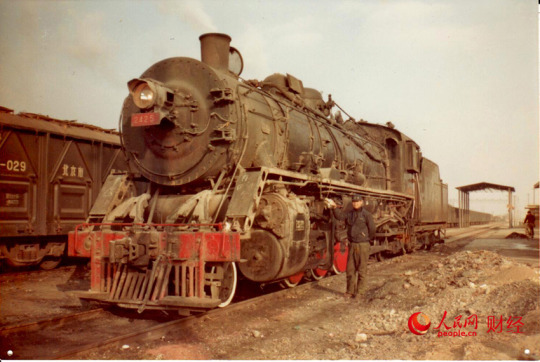
the locomotive is a JF class. the class of locomotive which would become the JF was originally designed and built in America and sent to Manchuria to work on the Japanese colonial railways and designated "Mika" or 'Mikako". After World War I, Japan assumed operation of the Sifang locomotive shops built by the Germans during their occupation of China, which was then used by Japan to produce Mikas of the same design as those orders from the United States. After China was liberated by the PLA the railways were recategorized and standardized and the Mika was renamed JF standing for - Jie Fang (Liberation). Spare parts leftover at the Sifang Locomotive Works from the Japanese Occupation at the Sifang Locomotive works were used to produce the first locomotive produced in the People's Republic and the first truly indigenous locomotive - JF no 2101 - which would enter service on railroads run for the benefit of the country and its people rather than colonial powers. The JF would be the backbone of the Chinese railway in the early years of the People's Republic as the railway network grew and the country rapidly industrialized. it was a reliable design examples of which lasted in service for at least 86 years. by 1980 the entire railway network had undergone a drasric transformation compared to just 40 years previously- from one with locomotives built by colonial powers to work on colonial railways to domestically produced locomotives to work on railways which were for the benefit of the country itself and not a colonial power.
even at the time the "before" picture in the aforementioned post had been taken, there had been people who had witnessed a massive and almost unimaginable transformation within the Chinese railway network. who started as employees in Japanese colonial railways or German colonial locomotive works who ended their careers building locomotives in not only a newly liberated country but a worker's state. and i think that's as impressive if not more impressive than the high speed rail construction.
250 notes
·
View notes
Text
i sent you pics of high speed rail networks pls respond
165 notes
·
View notes
Text
*Gazes longingly at Europe’s high speed rail network with feelings of immense lust and horniness*
113 notes
·
View notes
Photo

Routes where high-speed rail would be faster than both car or airplane.
3K notes
·
View notes
Text
The shapes of railway networks
A while ago @ariadsishereagain asked me about countries that have no railway networks, and what I think of them. That's a fascinating question that has been in my mind ever since, because the truth is you can tell a lot about a country and in particular it's history during the 19th and early 20th century by its railway network. So let's do that. And the best way to do that is by looking at the incredibly detailed open-source world railway map OpenRailwayMap, a part of the OpenStreetMap project. I really recommend it! And let's start with one of my favorite examples of how railway networks differ:

At this zoom level the site sadly only shows incomprehensible internal abbreviations rather than city names, so let me explain: What we have here are France and Germany, along with some of the UK and Italy, some of various neighbouring countries and all of Switzerland, Belgium and Luxembourg.
France and Germany are the ones that I find the most interesting, because the shapes of their networks are so different. Not only is the german one much more dense, but you can see completely different patterns.
In France, the job of railroads is to bring people to Paris (PLY, short for Paris Gare de Lyon) The lines stretch out into every part of the country, but almost all of them converge onto mainlines going into Paris. You can see some lines along the coasts and the borders, and there is a medium distances circle around Paris (passing MZ, DN, TO, short for Metz, Dijon, Tours). This whole pattern is known as the Legrande Star, after Baptiste Alexis Victor Legrande, the french government official who designed it. His goal was to provide great access to Paris, the nation's undisputed political, cultural and economical centre. A couple of decades later, Charles de Freycinet added plans to connect all departments to the railway network, but he still followed the idea that the ultimate goal of almost every rail line was Paris. And so it was, and largely remained. Even the high speed lines, in red, follow this pattern to this day.
A result is that you will have to go to Paris whether you want to or not. Lille-Strasbourg? You're going through Paris. Bordeaux-Dijon?

You're going through Paris, and get to make your own way from Gare Montparnasse to Gare de Lyon on the Metro (and it isn't even a direct metro, you have to change trains). It's a massive detour but it's not like you have a choice.
Even if there is a direct TGV or a connection outside the main stations of Paris, you're still ending up very much near Paris; the difference is just that you're not going via the city centre, but rather via Disneyland. Legrande wanted to bring people to Paris; he was less concerned about connecting other places with each other.
Now compare Germany, and you will see a network that is more dense, but most importantly, utterly chaotic. You can see hints of a France-like star around Berlin (BSPD, short for Berlin Spandau, which isn't the most important station but what can you do), but it's really only dominating its immediate surroundings, the region of Brandenburg. You can see vague hints of a similar star around Hamburg (AH; don't ask) or Munich (MH), but also a massive tangle around the Rhine-Ruhr industrial area (around KD), or around the Frankfurt am Main area (FF). Red high speed lines are essentially random. Some of them do go to Berlin, sure. But many, like the one from Cologne to Frankfurt (KD to FF) or the one from Hanover (HH) south, do not.
And that really reflects the history. Germany wasn't a unified country when railroad construction began, and even though it did unify shortly thereafter, there's no hiding that its different parts developed separately, with no central planning, ever since the middle ages. Germany doesn't have a single central city like France. Berlin is the biggest and most important city, but not by far. Hamburg has huge cultural and industrial influence, Frankfurt is the most important financial centre and airport, Munich is huge, and there are agglomerations like the Rhine-Ruhr region that used to beat all of them in terms of industry. And the rail network, with no single central focus point, reflects that.
That doesn't mean Germany doesn't have its own blind spots. Due to being split in two, the east-west links aren't great. Getting e.g. from Cologne (near KD) to Dresden (DH) is pretty painful. Ironically, Berlin is one of the places that really suffers from this. There are plenty of trains to it from Cologne but they take forever, and you can see why: A lot of the route isn't high speed, it's just more or less upgraded normal lines. If you have a single destination, then it's easy to build all the lines there. If you want high-speed connections between everything, that's more difficult. (Also, our government isn't investing anywhere near enough into the rail network, both compared internationally and on its own terms, but that's a different issue)
Other countries in Europe tend to be somewhere between the extremes. Spain is fairly centralised around Madrid.
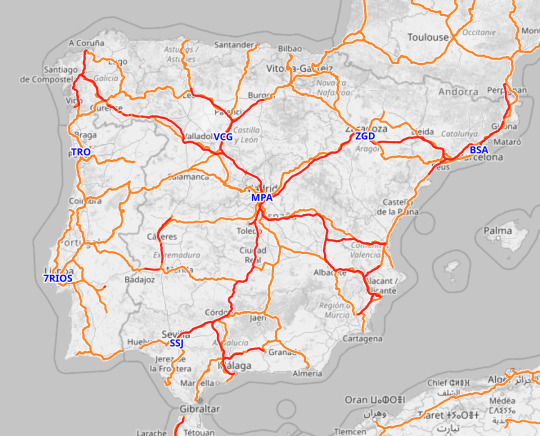
The UK is just as focused on London as France is on Paris, but it has strong regional networks around Leeds and Sheffield, and the weirdness in Scotland (four different lines between Glasgow and Edinburgh and counting!).
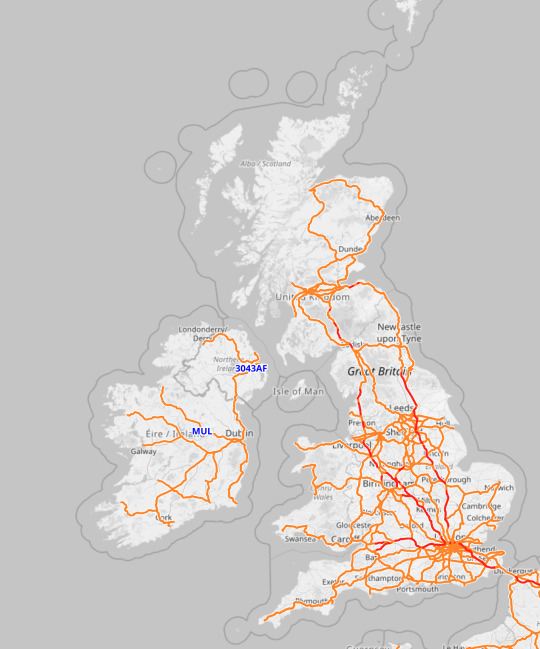
Italy, especially south of the Po valley, almost looks like a ladder: Lines are either on the one side of the Apennines or the other, with a few brave ones crossing through.
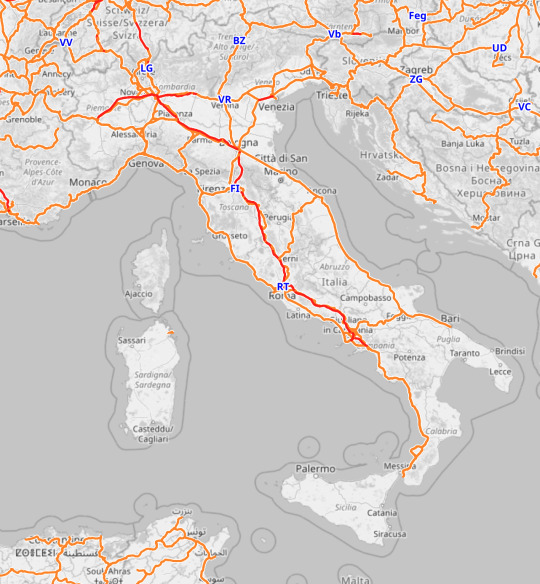
This works overseas as well. Describing the continental US as "like Germany" is certainly going to raise some eyebrows, but the map doesn't lie:
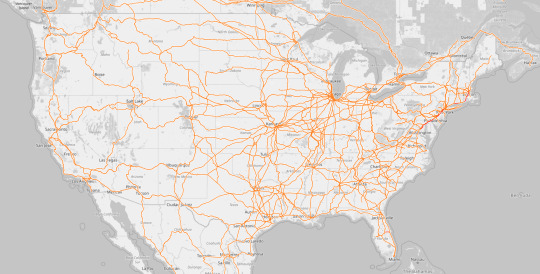
It's all on a completely different scale, but it's also a federal country with no one single clear centre. Yes, New York and Los Angeles are big and important, but neither is an all-powerful centre of the nation. What's fun about the US is that it's almost gradient-like: The more west you go, the fewer the railroads get. You can also nicely see the Alleghenies by the shadow they cast: Just a few brave rail lines managed to make their way through or around. Other characteristic items are the huge tangle that is Chicago, the closest thing the US has to a railroad capital; and the many places where lines are almost duplicated (just count how many different ways you can get from Chicago to Memphis, or Chicago to Cleveland), thanks to different competing railway companies that all hated (and sometimes still hate) each other's guts.
So that's what's mostly considered the "western world" or "industrialised world". I skipped Japan, China and India because the post is going to get too long no matter what, but they're all fascinating as well.
But if we go away from there look at countries where the colonialism was less settlers and more exploit mostly from afar, we see another very odd pattern emerge, like here in sub-saharan Africa:

The selection is somewhat arbitrary because you can find the same pattern everywhere south of the Sahara, and in one case (Mauretania) even in the Sahara: A railroad that goes straight to the coast. (The isolated sections inland are due to issues with the map software, they're all connected to one of the lines to the coast)
This kind of railroad is designed to extract a country's resources, and not much else. In Mauretania (not in this picture), that's iron ore. Elsewhere it might have been other ores, precious metals, gemstones, but also very often agricultural products, spices, dyes. The railway line exists to take these things, and bring them to a port. The line is not designed to actually help the nation grow economically. Think about it: All things being equal, you're probably just as likely to want to go parallel to the coast as perpendicular to it.
Also, each of these lines were built because there's something interesting at the end of it, or at least someone suspected there might be. If you wanted to develop the area, it would make sense to trade the interesting stuff in Togo with the interesting stuff in Benin. But the railway lines are not set up for that at all. The goal is to get the interesting stuff to a ship, and occasionally soldiers to the place where the interesting stuff comes from.
These days, the area that I screenshotted here is actually massive, full of people. The city of Abidjan has more than four million inhabitants (more than Berlin), Lomé has 1.7 million, Cotonou and Porto-Novo come close to a million if taken together, and nobody's quite sure about Lagos, but it's at least 14 million, and the metropolitan region might be 24 million. This is a band of cities that researchers think might, in the next few decodes, become on par with Washington-Philadelphia-New York-Boston in the US, or the Tokyo-Osaka in Japan.
And the rail connections in this region do not reflect this at all. A high speed passenger line and/or a heavy duty freight line could allow all these places to do business with each other, allow people to move to or visit each other, and just spur a lot of economic development. But the powers that built the lines, the colonial powers, were not interested. They had their harbour, and the region behind it, and they just wanted to extract whatever was there.
To be clear, that does not mean the railroads are evil now. Selling natural resources is still better than bringing no money into the country. And there are a lot of places where railroad junctions and depots became the point where cities were founded, so in some countries these lines do end up connecting the most important cities, more or less by accident. It's just that other lines or more lines are sorely missing.
A simple example for how this could look like is provided by Australia, where the colonists were settlers and did want to develop the land economically:

You have the lines from the coast inland, and sometimes quite a lot of them. But you can also see a line along the east coast, connecting the cities, and you can see that someone said "we need to build a railroad across the entire continent. No, two actually". That is not to say that Australia does everything right with railroads, they have a lot of weirdness there. But you can see that the railroads had more jobs than to just move resources to ships.
(The big exception is the Pilbara region, in the north west, with its odd tangle of lines. Those are all just resource extraction lines, where the world's heaviest freight trains haul iron ore from various mines to various ports. The mines and ports are owned by different mining companies that don't like each other, so everybody has their own line from their own harbour to their own mine, even if a different line would have been shorter. That's why you get the tangle there.)
So, that's basically it. The railroad map of a country shows you a lot about how a country works, and more specifically how it worked during the late 19th and early 20th century, when most railroads were built. Where they lead to and where they don't reflects what planners thought of as important, and in turn, it has shaped the way these countries developed. And personally, I always find this endlessly fascinating.
#railroads#maps#i suppose you could take the 6 to bercy and walk from there but it's still not exactly convenient
299 notes
·
View notes
Text
People overstate the importance of High-speed Rail to a rail network, frequency, accessible destinations, cost, and reliability are all more important than speed in getting people to use a railway network
906 notes
·
View notes
Text

Summary: You really hate him, but he’s also got a massive cock.
Pairing: Yuta x fem!reader
Tropes: enemies with benefits
Genre: smut
Rating: R 18+
Warnings: language
Smut Warnings: arguing as dirty talk, big cock Yuta, unprotected sex, belly bulging
Word Count: 359
Note: for the Tarot Card Drabble Event
Requested by: @drunk-on-hwa
Special Tags: @sanjoongie @umbralhelwolf @yoonguurt @kwanisms
Six of Wands ➾ HUGE COCK, wants to be the best, over the top

“Fuck you.” you snarl at the man above you.
“Yes, you are,” Yuta teases, “just cause I’m fucking you- fuck- doesn’t mean I like you.”
You aren’t entirely sure how you ended up in this situation. You and Yuta quite literally hate each other, but here you are underneath him getting absolutely railed. Not that you’ll ever admit it, but Yuta has a massive cock. No one you’ve dated or hooked up with could compare to him. His girth alone has your eyes rolling back, not to mention how long he is. It’s to the extent that each time he thrusts fully into you, there’s a bulge in your belly showing exactly where he is inside you.
“Are you that enamored by a big cock? What? Am I the only one who can please you?” he chuckles sadistically.
“N-no.” you curse yourself for stuttering.
“N-no.” Yuta mocks you, “Fuckin’ seems like it. Damn, if I had known you were that unsatisfied, I would’ve fucked you sooner.”
You choose not to think about his comment too deeply. The way he’s thrusting into you at a brutal pace is enough to keep your mind off the underlying tone of his comment. As much as you don’t want to, your hands fly up and tangle in his hair, tugging at the long locks. You hear him mumble another teasing comment at you, but you can’t be bothered to register it. Your orgasm comes hurling at you at full speed. Before you can even process your high, you feel Yuta pull out and cum across your belly. You unintentionally let out a whine, subconsciously wishing he came inside you. Yuta sits back on his heels and pushes his hair out of his face.
“Whine all you want,” he bites, “I hardly like you enough to fuck you let alone fuck you full of my cum. We’ll see how far we get in that whole ‘hatred’ thing, though.”
He walks away and returns with a damp rag to wipe the cum away. You feel the flutter of something in your chest at the gesture. You hate him, though; you know you hate him. Right?

COPYRIGHT FLOWERBOYKUN 2023© ALL RIGHTS RESERVED — reposting/modifying any fic or piece of original writing posted on this blog is not allowed. Translations are not permitted.
Networks: @neohub @kwritersworld @k-vanity
Tag List: @jaehunnyy @ericssmile
#yuta smut#neohub#kwritersworldnet#kvanity#nct fanfic#nct 127 fanfic#nct x reader#nct 127 x reader#nct smut#nct 127 smut#yuta fanfic#yuta x reader
105 notes
·
View notes
Text
If you ever feel like you don't deserve where you are right now, remember that Network Rail, an organisation that very infamously can't build high speed rail in the UK, has a consulting contract on California HSR
26 notes
·
View notes

